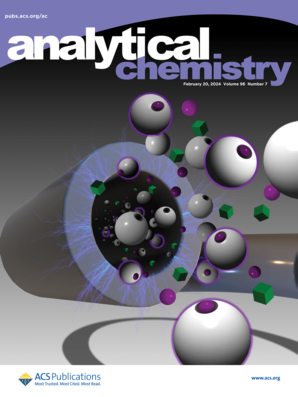A Nanoenzyme-Sensitized Photoelectrochemical Biosensing Platform Integrated with a Two-Step Radical Polymerization Signal Amplification Strategy for Ultrasensitive Detection of PTP1B Activity.
IF 6.7
1区 化学
Q1 CHEMISTRY, ANALYTICAL
引用次数: 0
Abstract
Dephosphorylation is an essential process in cellular signaling with protein phosphatases playing a critical role in cellular functions and disease mechanisms. Herein, a novel and ultrasensitive photoelectrochemical (PEC) biosensing platform for detecting protein tyrosine phosphatase 1B (PTP1B) activity was developed, based on the sensitization effect of a magnetic ZnFe2O4@ZrMOF nanoenzyme integrated with a two-step radical polymerization signal amplification strategy. The PTP1B-specific phosphorylated peptide (p-peptide) was immobilized on a 96-well plate and then coupled to the ZnFe2O4@ZrMOF nanoenzyme through coordination between its phosphate groups and Zr4+ ions. When PTP1B was present, the p-peptide was specifically recognized and dephosphorylated, causing the release of ZnFe2O4@ZrMOF. After magnetic separation, the detached ZnFe2O4@ZrMOF nanoenzyme, with peroxidase (POD)-like and photoresponsive oxidase (OXD)-like activities, was used as a signal probe, which not only exhibited a PEC signal sensitization effect on the AgInS2/Ag2S/magnetic ITO (MITO) photoelectrode but also triggered two-step radical polymerization reactions to form the ZnFe2O4@ZrMOF/polydopamine (PDA)/ poly(ferrocenylmethyl methacrylate) (PFcMMA) composite for further enhancing the PEC signal amplification. The proposed PEC biosensing platform achieved ultrasensitive detection of PTP1B activity, demonstrating a wide linear range (10 aM-0.1 μM) and an ultralow detection limit (3.92 aM), along with good reproducibility, satisfactory stability, high selectivity, and promising practical applicability. This work provides a prospective method for protein phosphatase activity assay, facilitating early disease diagnosis and therapeutic development alongside an innovative signal amplification strategy for advancing PEC biosensor sensitivity.结合两步自由基聚合信号放大策略的纳米酶敏电化学生物传感平台用于PTP1B活性的超灵敏检测。
去磷酸化是细胞信号转导的重要过程,蛋白磷酸酶在细胞功能和疾病机制中起着关键作用。本文基于磁性ZnFe2O4@ZrMOF纳米酶的敏化效应和两步自由基聚合信号放大策略,开发了一种新型的超灵敏光电化学(PEC)生物传感平台,用于检测蛋白酪氨酸磷酸酶1B (PTP1B)的活性。将ptp1b特异性磷酸化肽(p肽)固定在96孔板上,通过磷酸基与Zr4+离子的配位偶联到ZnFe2O4@ZrMOF纳米酶上。当PTP1B存在时,p肽被特异性识别并去磷酸化,导致ZnFe2O4@ZrMOF的释放。磁性分离后,分离得到具有过氧化物酶(POD)样和光响应氧化酶(OXD)样活性的ZnFe2O4@ZrMOF纳米酶作为信号探针,不仅对AgInS2/Ag2S/磁性ITO (MITO)光电极表现出PEC信号敏化作用,而且引发两步自由基聚合反应,形成ZnFe2O4@ZrMOF/聚多巴胺(PDA)/聚二茂铁基甲基丙烯酸甲酯(PFcMMA)复合材料,进一步增强了PEC信号放大。该PEC生物传感平台实现了PTP1B活性的超灵敏检测,具有宽线性范围(10 aM-0.1 μM)和超低检出限(3.92 aM),重现性好,稳定性好,选择性高,实用性强等特点。这项工作为蛋白磷酸酶活性测定提供了一种前瞻性的方法,促进了疾病的早期诊断和治疗开发,同时为提高PEC生物传感器的灵敏度提供了一种创新的信号放大策略。
本文章由计算机程序翻译,如有差异,请以英文原文为准。
求助全文
约1分钟内获得全文
求助全文
来源期刊

Analytical Chemistry
化学-分析化学
CiteScore
12.10
自引率
12.20%
发文量
1949
审稿时长
1.4 months
期刊介绍:
Analytical Chemistry, a peer-reviewed research journal, focuses on disseminating new and original knowledge across all branches of analytical chemistry. Fundamental articles may explore general principles of chemical measurement science and need not directly address existing or potential analytical methodology. They can be entirely theoretical or report experimental results. Contributions may cover various phases of analytical operations, including sampling, bioanalysis, electrochemistry, mass spectrometry, microscale and nanoscale systems, environmental analysis, separations, spectroscopy, chemical reactions and selectivity, instrumentation, imaging, surface analysis, and data processing. Papers discussing known analytical methods should present a significant, original application of the method, a notable improvement, or results on an important analyte.
 求助内容:
求助内容: 应助结果提醒方式:
应助结果提醒方式:


